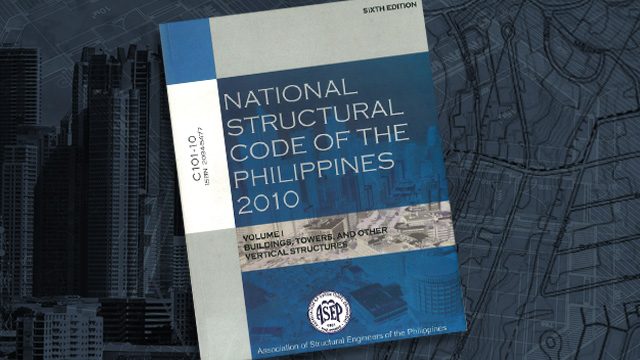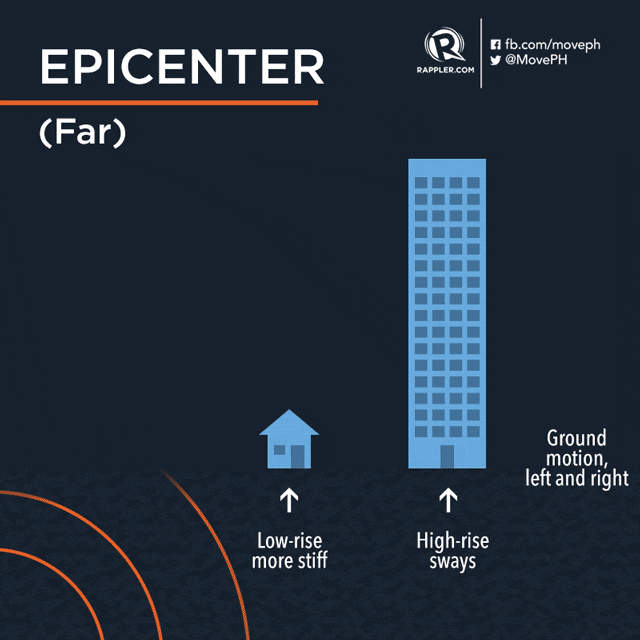SUMMARY
This is AI generated summarization, which may have errors. For context, always refer to the full article.

Take this Rappler interactive quiz and find out if your house is earthquake-ready.
QUIZ: Part 1: Can your house withstand major earthquakes?
MANILA, Philippines – Why is it important for homes and buildings to meet standards set in the Structural Code?
The code prescribes requirements which, if followed, ensure that homes and buildings will not sustain major structural damage when an earthquake strikes. In effect, it protects homeowners and building occupants.
It is developed and updated regularly by the ASEP and is approved by the Department of Public Works and Highways (DPWH), the national government agency mandated to enforce structural standards in the Philippines.
The code derives its mandate from the National Building Code of the Philippines, which was enacted by Congress in 1972, years after the Casiguran Earthquake destroyed the Ruby Tower in Manila. It was later revised by former President Ferdinand Marcos in 1977 through Presidential Decree No. 1096, which allowed updating of structural standards without a need for new legislation.
Updates are integrated by the ASEP when hazard scenarios, which are not yet factored in when the previous versions of the code were drafted, crop up. Since 1972, the Structural Code has been updated 6 times.
The present NSCP was written in an “ultimate strength basis.” This means structures following the code should be able to withstand earthquakes with magnitudes 8 to 9 on the Richter scale, according to engineer Cesar Pabalan, National Director of Philippine Institute of Civil Engineers and former ASEP President.
Critical 1992 update
In 1992, two years after the 7.8-magnitude Luzon earthquake, a crucial update was made to the structural code.
The Luzon quake severely hit Baguio City, Cabanatuan City in Nueva Ecija and Dagupan City in Pangasinan, leaving 2,412 people dead and around US$369.6 million worth of damage to property. A number of luxury hotels in Baguio, including Hotel Nevada, collapsed during the 45-minute tremor. (READ: Faith and science: Lessons from the 1990 Luzon earthquake)
The 1992 update to the structural code improved standards for ductility of the whole structure, according to former ASEP Presidents Miriam Tamayo and Toby Tamayo.
Ductility is the ability of a structure to undergo large deformations while still keeping its capacity to carry its intended loads. It is also the ability of the structure to move and shake without breaking.
One of the updates to ductility prescribed closely-spaced steel ties in columns and stirrups for beams of houses. For reinforced concrete, additional ductility may be provided by putting the right amount of steel reinforcement in beams and columns.
Ductility of structural elements is important when an earthquake strikes, said Toby.
“Why? For people to have extra time to get out of the building.”
The Structural Code was last enhanced in 2010, according to Toby, who is part of the editorial board for the code update.
Among those considered was an earthquake design similar to the Uniform Building Code of the United States.
Seismic provisions of the structural code have always been patterned from the Structural Engineers Association of California (SEAOC) code and the Uniform Building Code of the United States, according to Pabalan.
SEAOC code considers earthquake scenarios along the famous San Andreas Fault line in California, where an estimate of 3,000 casualties resulted after the area was hit by a 7.8-magnitude earthquake in 1906.
High-risk buildings
The SEAOC developed an earthquake-resistant design for buildings. The Uniform Building Code, on the other hand, has the most up-to-date seismic design requirements. It is updated every 3 years.
The newest requirement added was the assessment of the structures’ nearness to the fault line and a “redundancy” criteria that ensures safety of the entire structure.
Structural response mechanisms that help structures withstand vibration from earthquakes were also included.
For 2015, a new edition will be made in response to the country’s experience with 315-kilometer per hour winds during Typhoon Yolanda (international code name: Haiyan), said Pabalan. The current code can only withstand 250-kilometer per hour winds.
The 2015 edition of the structural code will be released by the end of the year or early 2016 next year, says Pabalan.
The big problem in the Philippines, according to Miriam, is that a big percentage of the houses and structures are non-engineered – they were built without the benefit of engineers and structural codes.
“Building owners still need to consult experts,” emphasized Miriam.
Structural integrity
Following the code does not necessarily guarantee a totally “earthquake-proof” house, said Pabalan. This is because a house can still sustain non-structural damage during shaking. Windows, for instance, may still break as a result of the shaking. Other non-structural finishes may also sustain damage.
The goal of the code is to ensure low probability of structural collapse.
In the “How Safe is My House” project for instance, PHIVOLCS, ASEP, and JICA outline the features of a properly-built Concrete Hollow Block (CHB) house that follows the current structural code. The experiment compared a code-compliant structure and a commonly-built CHB house in the Philippines. These were the results of the experiment:
| Features | Properly-built | Improperly-built |
|---|---|---|
| Concrete hollow block wall | 6 inches thick (400 x 200 150mm) | 4 inches thick (400 x 200 x 100mm) |
| Vertical steel bars | 10mm diameter spaced 40cm from each other | 6mm diameter spaced 90cm from each other |
| Horizontal steel bars | 10mm diameter spaced 60cm from each other or laid every 3 layers | 6mm diameter spaced 60cm from each other or laid every 3 layers |
| Mortar mix (Cement: sand) | 1:4 Compacted | 1:4 Not compacted |
| Roof frame/roofing | Wood/Galvanized iron sheets | Wood/Galvanized iron sheets |
Where is it safe to build?
All said and done, where is it safe to build homes?
Pabalan noted that the code mandates a “no-build zone” which is 5 meters from both sides of the fault line. (READ: MMDA to bring‘earthquake house’ to barangays near fault line)
This is to make sure that buildings will not be affected by ground fissure, said PHIVOLCS Director Solidum. (READ: 57 subdivisions, villages traversed by West Valley Fault)
Beyond the “no-build zone,” the height of the building and the distance from the source of the earthquake can affect the level of risk.
Low-rise structures near the fault are more at risk when the West Valley Fault line moves, Pabalan said.

High-rise buildings near the fault, on the other hand, can withstand the shaking better because they are more flexible.
Away from the epicenter, tall structures are more vulnerable as the ground moves slower, making high-rise buildings sway more slowly.

Cutting costs can put lives at risk
Whether you build near a fault line or not, the design of the building is important to ensuring safety during earthquakes.
“If we really want mitigation, it has to start with the design,” Toby emphasized.
“We want to build houses, but we also want to cut the cost, so we do not get engineers and architects. It’s the wrong concept of saving,” he said.
The correct process, according to Toby, should be to consult an engineer, get a building permit, and have a responsible person at the site during construction.
These may add to costs, but it could spell the difference between safety and peril should an earthquake strike.
“These are long term, foresight-measures for mitigation.” – with a report from Aika Rey/Rappler.com
Add a comment
How does this make you feel?
There are no comments yet. Add your comment to start the conversation.